14th Annual Maritime Risk Symposium to be Held Nov. 14-16 at SUNY Maritime

The 2023 Maritime Risk Symposium (MRS) will be held Nov. 14-16, 2023, as an in-person event, hosted by Maritime College, State University of New York (SUNY) at the Maritime Academic Center. The theme of the 14th annual event is “Managing Impacts of Supply Chain Disruptors, Renewable Energy, Emerging Technology on the Maritime Transportation System (MTS)” with a focus on offshore infrastructure risk and disruptors. Founded in 1874, Maritime College is the oldest maritime college in the United States, providing mariner training for 150 years.
Change of Command at USCG R&D Center
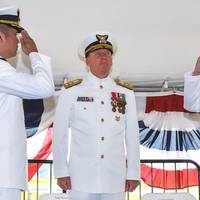
The U.S. Coast Guard Research and Development Center (RDC) held a Change of Command on June 16, 2023, at 10 a.m. at Fort Trumbull in New London. Current RDC Commanding Officer, Capt. Dan Keane, was relieved by Capt. Michael Chien. Capt. Keane held command since May 1, 2020. He retires with 24 years of service.During Capt. Keane’s tenure, the command operated seamlessly during the height of the COVID-19 pandemic. Research continued and the approved portfolio was executed. Highlights included the command celebrating its 50th anniversary…
USCG Research and Development Center Turns 50
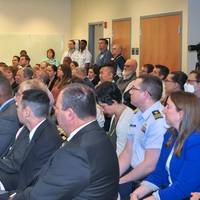
The U.S. Coast Guard Research and Development Center (RDC) on Monday celebrated its 50th anniversary during an open house event at the center’s campus next to Fort Trumbull in New London, Conn.The event, designed to showcase RDC history and ongoing work, and provide an opportunity to speak with its researchers, focused on several key themes, such as the impact past and current researchers have had on the service as well as appreciation for Southeastern Connecticut, including the City of New London, for its support to the Coast Guard and its resident RDC.On Sept.
US Coast Guard and Space Force Partner on R&D
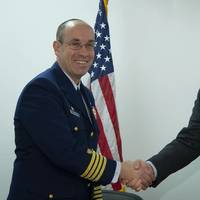
The United States' Coast Guard and Space Force are teaming up to share information resources and identify opportunities for applied research and advanced technology development.A memorandum of understanding (MOU) inked by the U.S. Space Force Science, Technology, and Research Directorate and U.S. Coast Guard Research and Development Center on January 19 will expand Space Force access to USCG Research and Development Center facilities, infrastructure and personnel.USSF Dr. Joel Mozer, USSF science, technology and research director, signed the MOU alongside Capt.
US Coast Guard R&D Center to Celebrate 50 Years
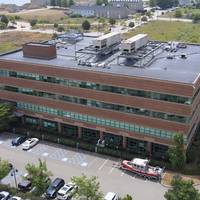
The U.S. Coast Guard Research and Development Center (RDC) in New London, Conn. is planning to celebrate its 50th anniversary with a multi-faceted community event.On September 1st, 1972, the Coast Guard Commandant established the RDC as an interim facility at the University of Connecticut’s Avery Point campus in Groton pending construction of a permanent facility. In 2009, the RDC moved to the “Coast Guard City” of New London near Fort Trumbull.For 50 years, the RDC has developed…
Interview: Dan Keane, Commanding Officer, USCG RDC
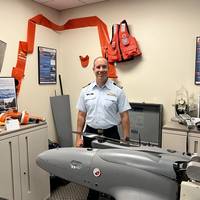
United States Coast Guard service is a family legacy for Dan Keane, who today serves as the Commanding Officer of the U.S. Coast Guard Research and Development Center in New London, CT."My dad was in the Coast Guard (for nearly 37 years), so this is a way of life for me,” said Keane in explaining that a Coast Guard career “was just something I always knew I wanted to do … it’s a family tradition for me.”The Coast Guard R&D center in New London is “relatively small with just over 80 people here at the RDC” said Keane…
US Navy, Coast Guard Extend Maritime R&D Partnership
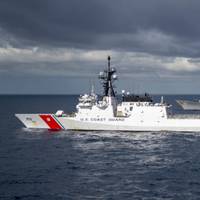
The Naval Postgraduate School (NPS) in Monterey, Calif. and the U.S. Coast Guard Research and Development Center (RDC) in New London, Conn. agreed to a memorandum of understanding (MOU) on April 14 extending for five more years their previous three-year direct collaboration on joint research projects and exchanges. The extension is a result of the Tri-Service Maritime Strategy (TSMS) released in December, which underscored the need for joint cooperation in today’s security environment.
Sea Machines Promotes Bourque
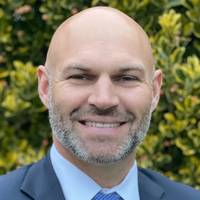
Sea Machines Robotics, a developer of autonomous command and remote-helm control systems, has promoted Phil Bourque to the role of business development and sales director, U.S. Government, effective immediately.In his new position, Bourque will primarily focus on advancing the company’s government contracts and related special projects. Bourque has relocated to the Norfolk, Va. area for the role, a move that enables Sea Machines to establish a new company foothold closer to key…
Maritime Risk Symposium 2020: Maritime Resilience in Black Swan Events
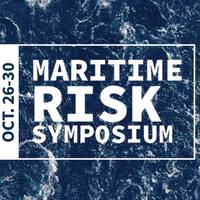
In 2007, scholar Nassim Nicholas Taleb, who holds a doctorate from the University of Paris, wrote a bestselling book titled “Black Swan,” which proposed a theory involving unpredictable events with significant impact. Taleb believed that a black swan event was an outlier with significant impact and, once it occurs, is the source of deep reflection and rationalization. Since the book’s publication, a significant number of research efforts have been developed to consider possible black swan events that significantly impact the Maritime Transportation System (MTS) and the Maritime Global Commons.
Maritime Risk Symposium, Nov. 12-15 at SUNY Maritime
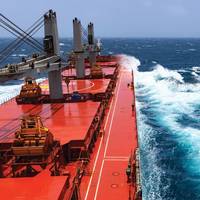
The State University of New York Maritime College, in collaboration with the U.S. Coast Guard, National Academy of Sciences, academic institutions, industry partners, and federal, state and local agencies, will host the 10th Annual Maritime Risk Symposium (MRS 2019) Nov. 13-15, 2019, at New York Maritime College located in the Bronx, New York.MRS 2019 will bring together academics, government and commercial entities to discuss the threats, challenges and risks associated with the Marine Transportation System with a focus on current and future marine transportation challenges and threats.
AI & Machine Learning, Possible Force Multipliers for the Coast Guard

Artificial intelligence (AI) and machine learning (ML): mention these two terms and the listener may instantly think of the ads displayed as you view your favorite online news site. This is one version of what AI/ML might be. Given the state of AI and ML research today, these advanced mathematical techniques represent something the U.S. Coast Guard should explore for mission application. To do this, common definitions need to be created, challenges understood, and practical use…
USCG Arctic Satellites aim to Add Margin of Safety

The U.S. Coast Guard’s mission of keeping the seas safe will soon get an additional boost from space with two polar satellites. The two satellites, called “cube satellites” or “cubesats” for their small size of about 60 square centimeters, or a little under 2 feet, will be part of a payload on a SpaceX Falcon 9 rocket scheduled to launch from Vandenberg Air Force Base in California Nov. 28. Although the Coast Guard has used satellite technology for years, these two are the first to be entirely dedicated to a Coast Guard mission. The initiative is part of the U.S.
USCG Conducts Successful Oil Spill Test Burn
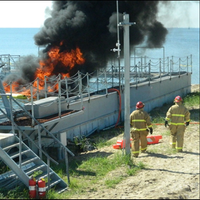
The U.S. Coast Guard Research and Development Center (RDC) conducted a successful test burn of oil using the purpose-built burn pan on Little Sand Island in Mobile Bay, Ala. during the week of September 17, 2018.Controlled, pre-planned burns conducted using the Joint Maritime Test Facility allow researchers to gather critical data to help oil spill responders determine best practices for operational use of in-situ burning, develop new equipment with procedures, and to refine training…
Answering the Call for Environmental Answers
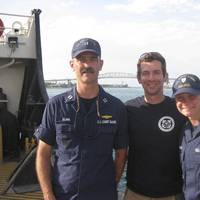
The Coast Guard has developed two separate mitigation system prototypes specifically designed for inland and offshore environments and tested them in the Kalamazoo River and Lake Huron.Whenever there is a need for oil, there will always be a risk of oil spills. This is no less true for bituminous sands, commonly known as oil sands or tar sands. Oil sands are mostly found in Alberta, Canada, and comprised of bitumen, sand, clay and water. They are typically viscous, with a texture similar to peanut butter.
Vice Commandant Visits USCG Research Center
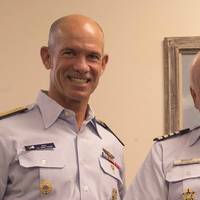
The U.S. Coast Guard Research and Development Center (RDC) in New London, Conn. hosted the service’s new Vice Commandant – Admiral Charles Ray on Wednesday. He was onboard the Service’s research center to receive an update on several projects, including CubeSATS, UUV, Small UAS, Sunken Oil, cUAS, Artificial Intelligence, and Blue Force Tracking. Additionally, he will celebrate the growing relationship between the RDC, commissioned in 1972, and the Coast Guard Auxiliary.Admiral Ray, a 1981 graduate of the Coast Guard Academy, is the Coast Guard’s 31st Vice Commandant.
Ship Tech: U.S. Coast Guard R&D Center
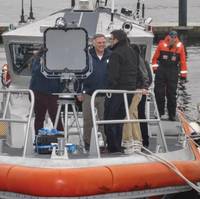
The U.S. Coast Guard Research and Development Center (RDC) in New London, Connecticut, is the service's only command conducting research, development, test and evaluation (RDT&E) support for all 11 statutory missions. Since its commissioning in 1972, RDC has been involved in over 2,000 projects and initiatives that have significantly benefited the Coast Guard and the components of the Maritime Transportation System. As the demand for research and development capability grows within the service…
Oil Spill Response: USCG Testing Evolves

Coast Guard R&D Center’s JMTF is a big part of the nation’s environmental research efforts. In 1972, the U.S. Coast Guard Research and Development Center (RDC) established the Fire and Safety Test Detachment (FSTD), which later became the Joint Maritime Test Facility (JMTF), at Coast Guard Sector Mobile in Mobile, Alabama. As part of the unit’s establishment, test facilities were also built on nearby Little Sand Island in Mobile Bay. Since its inception, multiple retired commercial vessels were used as test platforms ending with the State of Maine, which was removed in 2010.
Drones: Is the Maritime Industry Ready?
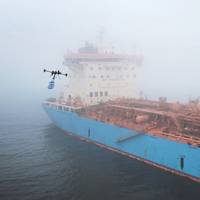
Unmanned aerial systems (UAS), or “drones” in common parlance, are not a part of the historical maritime vocabulary. At least not yet. While the term “drones” may conjure images from science fiction, the reality is that companies are designing commercial UAS for the private sector, and they are gradually permeating our daily life. Henry Ford is rumored to have opined on his invention of the automobile that if he had asked people what they wanted, they would have said “faster horses.” In the case of UAS…
Navy Patent SNARE Propeller Entangler
The small naval arresting rope entangler, or SNARE, helps stop boats from evading military & law enforcement inspections by entangling the craft's propellers. SNARE was designed by a team of engineers from NSWC Carderock, NSWC Dahlgren and the U.S. Coast Guard Research and Development Center. "For our part in the project, Carderock engineers designed and built a test bed for evaluating various concepts, developed concepts to test and conducted model scale tests," said project manager Kedric Eisenberg. "Engineers from Dahlgren and the U.S. The system fielded prior to SNARE was the running gear entanglement system, which, according to Eisenberg, worked well as a static barrier, but lost efficiency when launched from a platform. "We designed SNARE to more effectively stop fast boats.
RFP in Maritime Security Research
The DHS Maritime Security Center (MSC), led by the Stevens Institute of Technology, announces a competitive research opportunity to address challenges in maritime cyber security. This effort invites qualified researchers to propose projects that will provide DHS stakeholders with innovative research that addresses current challenges in maritime cyber security as outlined in the RFP. MSC plans to fund one award of up to two years and up to $350,000. Any questions should be directed to [email protected] no later than April 19, 2016. development of the current and future maritime security workforce. More information on MSC may be found on www.stevens.edu/msc. In November 2015, MSC co-hosted the Maritime Risk Symposium in conjunction with the U.S. Coast Guard Research and Development Center.
Coast Guard to Test Oil Spill Technologies in Arctic
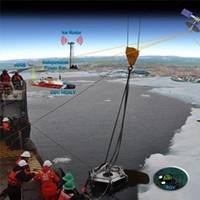
The U.S. Coast Guard Research and Development Center (RDC) plans to test and evaluate oil spill detection and recovery technologies in the Arctic Ocean as part of Operation Arctic Shield 2013. A multi-agency team of engineers and scientists led by RDC researchers will conduct a series of demonstrations in September aboard Coast Guard Cutter Healy to test and evaluate capabilities of various unmanned aerial systems (UAS), an unmanned underwater vehicle (UUV) and a remotely operated vehicle (ROV) to search for simulated oil spills.
Coast Guard to Test Arctic Oil Spill Technologies
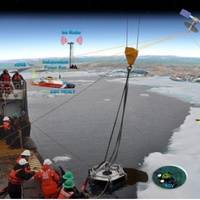
The U.S. Coast Guard Research and Development Center (RDC) plans to test and evaluate oil spill detection and recovery technologies in the Arctic Ocean as part of Operation Arctic Shield 2013. A multi-agency team of engineers and scientists led by RDC researchers will conduct a series of demonstrations in September 2013 aboard Coast Guard Cutter Healy to test and evaluate capabilities of various unmanned aerial systems (UAS), an unmanned underwater vehicle (UUV) and a remotely operated vehicle (ROV) to search for simulated oil spills.
Ampol Completes Oil Recovery Equipment Testing

Oil Stop Division of American Pollution Control Corp. (AMPOL) completed phase two of its contract with the US Coast Guard Research and Development Center for the testing of Submerged Oil Recovery Equipment. The contract was completed in November after successfully executing a variety of tests at the OHMSETT facility in Leonardo, New Jersey. The OHMSETT facility allows industry professionals to work with real oil in simulated environments. As a result of testing, adaptations were made to AMPOL’s Oil Stop Bottom Oil Recovery System (OSBORS).







